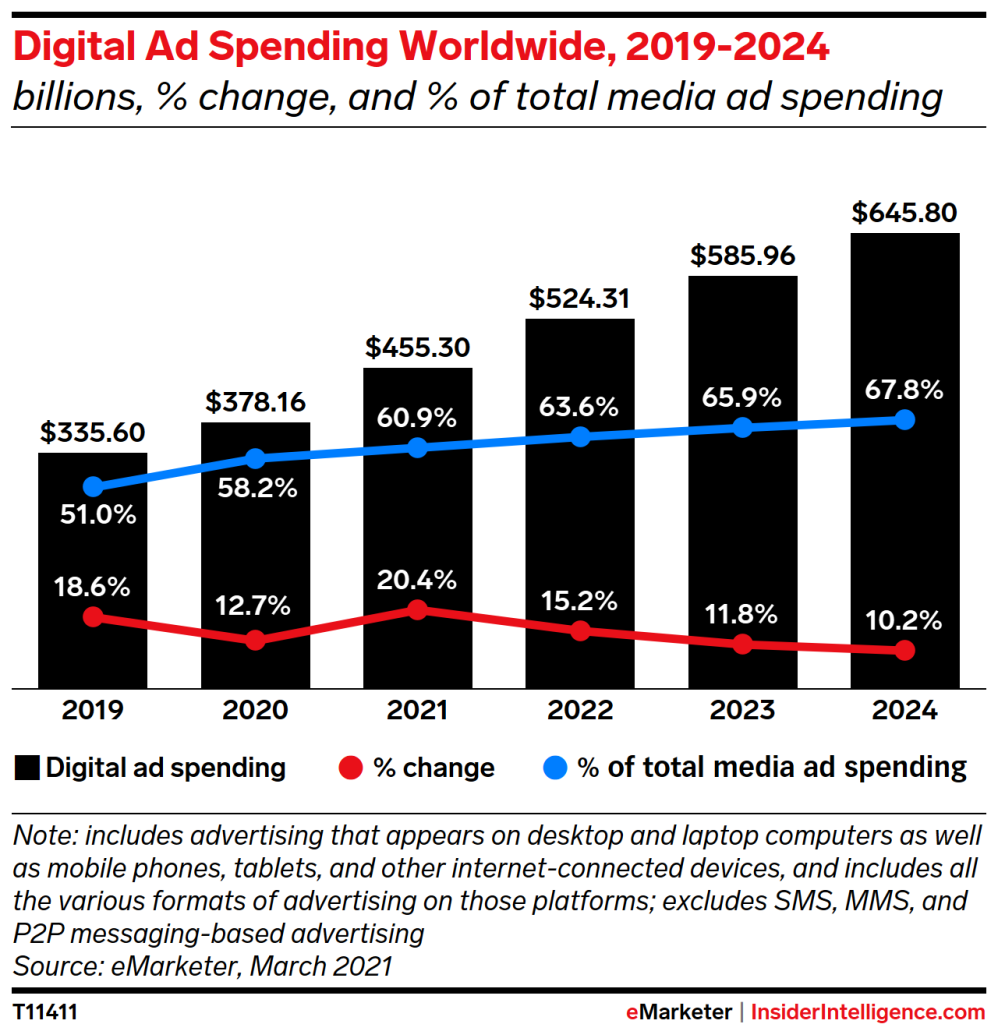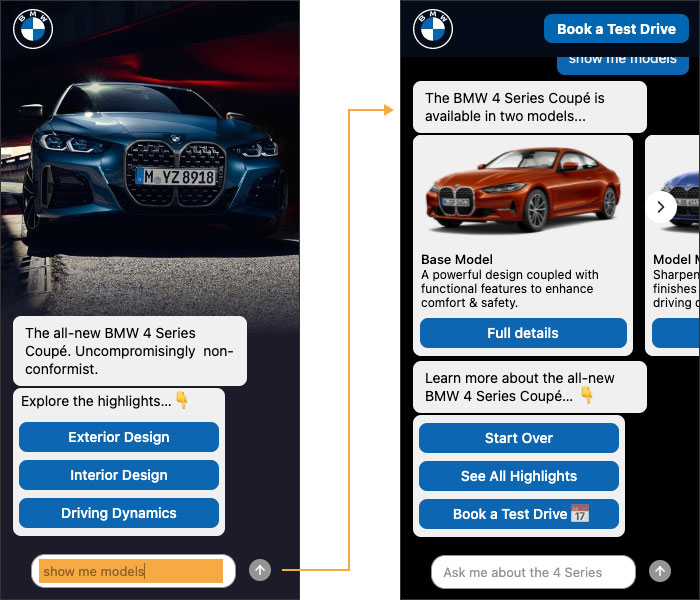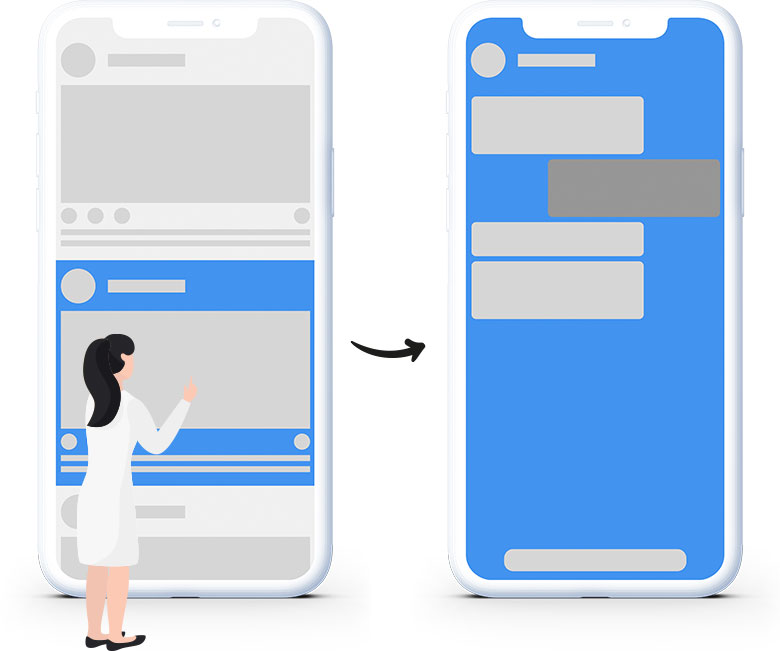Welcome to your go-to guide for mastering conversational advertising in 2025.
In this guide, you’ll find the essential knowledge and practical tactics needed to boost engagement and maximize your ROI. Whether you’re just getting started or looking to refine your approach, we cover everything from the basics to advanced implementation techniques. It’s time to move beyond traditional programmatic display ads and static landing pages and step into the future of advertising.
Looking to focus on a specific area? Our detailed table of contents makes it easy to navigate and find exactly what you need. Don’t miss the chance to enhance your advertising efforts. Keep reading to explore how conversational advertising can transform your campaigns and keep you ahead of the competition in 2025.
Part 2: What is Conversational Advertising?
Part 4: Conversational Programmatic Display Ads
Part 5: Conversational Social Campaigns
Part 6: Measurement and Analytics
Part 1: How Did We Get Here?
Here’s a simple question: Is this what online advertising would look like if the customer experience came first?



Are you tired of the same old digital ads that lack engagement and leave consumers feeling tricked? You’re not alone. Traditional digital ad formats like banner ads no longer cut it. In fact, a recent study found that only 7% of people who clicked on an ad did so because it was compelling.1
Check out some of these stats:
Of people who have clicked on an ad, 34% said it was a mistake, and 15% accused advertisers of tricking them into clicking.1
27 years after the first banner, we have…pretty much the same banners.
A change is overdue. The media landscape has undergone significant transformations, yet advertising still lags behind in terms of innovative formats and engaging user experiences. As a result, consumers are becoming increasingly blind to banner ads and showing less interest and involvement.
Some of these formats undoubtedly work for some brands. But the consumer engagement numbers don’t lie.
The really crazy thing? This isn’t just bad for consumers. It’s terrible for advertisers too! Yet look at the current and projected ad spend:3

A solution exists – conversational advertising presents a fresh approach that focuses on enhancing the customer experience and departing from antiquated industry norms. This revolutionary approach benefits both consumers and advertisers, allowing you to surpass average outcomes. Uncover the potential of conversational advertising and elevate your campaigns to new heights.
Part 2: What is Conversational Advertising?
At its core, conversational advertising leverages the natural way we communicate—through conversations. Whether written or spoken, conversations are our primary means of connecting with others.
For 2025, conversational advertising represents a fresh approach to engaging with consumers. By utilizing AI and conversational interfaces, brands can interact with their audience in a more natural and personalized manner. Instead of overwhelming consumers with traditional banner ads, conversational advertising invites them to engage in meaningful dialogues with the brand, fostering better customer experiences.
One of the standout advantages of conversational advertising is its ability to boost engagement. Through conversational interfaces, brands can offer a tailored and interactive experience, which not only captures attention but also builds stronger brand loyalty.
Additionally, conversational advertising provides valuable insights. As consumers interact with these interfaces, brands can collect data on preferences and behaviors, enabling more precise targeting and personalized advertising strategies.
Moreover, conversational advertising enhances the customer journey. By offering quick and easy access to information, brands can simplify the purchasing process, making it easier for consumers to find and buy products they love.
In summary, conversational advertising is a powerful strategy that helps brands increase engagement, gather important data, and improve the overall customer experience. It paves the way for more natural and personalized connections with consumers.
Here’s how it works…
Automated conversations, driven by machine learning and natural language processing, are structured around ‘intents’—the fundamental elements that guide the flow of a conversation.
Here’s a simple example of what an intent for an automotive conversational ad might look like if a user asks about available models…

Utterances in conversational ads are text-based (by clicking a button or typing in a question), but they can also be voice-based, particularly with mobile devices. Responses can be delivered back to the user as any combination of images, text, cards, and buttons – or specialized custom-built response formats.
At its most basic, a conversational ad is a bunch of intents that together help consumers get relevant information about a brand/product/service in a natural, conversational way.
Of course, things can get more involved – for example, if you’re collecting leads, allowing users to upload images, or pushing consumers down a specific path/funnel.
Now that we have a basic idea of how automated conversations work, let’s explore why these experiences engage consumers.
Part 3: Why Does Conversational Advertising Work?
Messaging is the #1 preferred format for consumers when engaging with a brand. Here’s why…
Personalized Interactions
- Messaging allows brands to tailor conversations based on individual preferences and behaviors, creating a more personalized experience that resonates with each consumer.
Immediate Responses
- Consumers appreciate the quick and real-time interactions that messaging platforms provide, reducing wait times and enhancing satisfaction with instant support and information.
Convenient Accessibility
- Messaging is accessible on various devices and platforms, making it easy for consumers to engage with brands anytime and anywhere, fitting seamlessly into their daily routines.
Interactive Engagement
- Unlike static ads, messaging encourages two-way communication, allowing consumers to ask questions, provide feedback, and engage in meaningful dialogues with brands.
Enhanced Trust and Transparency
- Direct messaging fosters a sense of trust as consumers feel they are communicating with a real, responsive entity, leading to stronger brand loyalty and credibility.
Seamless Integration with Programmatic Ads
- Messaging can be effortlessly integrated into programmatic display ads, enabling automated yet personalized interactions that enhance the overall effectiveness of advertising campaigns.

By prioritizing messaging in your advertising strategy, you tap into the preferred communication method of consumers, leading to higher engagement, better customer relationships, and ultimately, improved campaign performance.
Now let’s look at the different ways conversational advertising can be brought to life.
Part 4: Conversational Programmatic Display Ads
Conversational programmatic display ads blend creative conversational interfaces with the precision of programmatic advertising. Programmatic advertising leverages automated systems and algorithms to buy and display digital ads, ensuring highly targeted and efficient ad delivery.
By integrating conversational elements into programmatic display ads, brands can deliver personalized and interactive experiences to consumers. This combination allows for more natural and meaningful engagements, as ads can respond to user inputs and preferences in real-time. The result is higher engagement rates and more accurate targeting, as ads are tailored to individual behaviors and interests.
With conversational programmatic display ads, brands can move beyond traditional static advertising. Instead, they can create dynamic interactions that resonate with consumers, fostering stronger connections and improving overall campaign effectiveness. This innovative approach not only enhances user experience but also maximizes the impact of your advertising efforts.
At AdChat, we specialize in helping you implement conversational programmatic display ads that drive results. Embrace this advanced strategy to engage your audience more effectively and stay ahead in the competitive advertising landscape of 2025.
The key benefits of conversational display ads are:
- Higher Engagement Rates
- Conversational display ads invite users to interact actively, resulting in more meaningful and sustained engagement compared to traditional static ads.
- Personalized User Experiences
- By leveraging user data, these ads deliver tailored content that resonates with individual preferences and behaviors, making each interaction feel unique and relevant.
- Valuable Data Collection
- As consumers engage with conversational ads, brands can gather insightful data on user preferences and behaviors, enabling more informed decision-making and strategy refinement.
- Enhanced Customer Journey
- Conversational ads streamline the path to purchase by providing instant access to information and support, making the buying process smoother and more efficient for consumers.
- Improved Targeting and ROI
- With precise targeting capabilities, conversational display ads ensure that the right message reaches the right audience at the right time, maximizing the effectiveness of your advertising budget.
- Real-Time Adaptability
- These ads can adjust their messaging and approach in real-time based on user interactions, ensuring that the communication remains relevant and impactful throughout the engagement.
By incorporating conversational display ads into your strategy, you can create more engaging, personalized, and effective advertising campaigns that drive better results and foster stronger connections with your audience.
Part 5: Conversational Social Campaigns
IImagine launching an in-app conversational experience seamlessly across platforms like Twitter, Facebook, Instagram, and LinkedIn.
With conversational interfaces, your social ads transform into personalized and interactive engagements for consumers. This approach not only boosts engagement levels but also integrates naturally within the social platforms users love. Unlike traditional ads that can interrupt the browsing experience, conversational social campaigns feel like a natural part of the conversation, making interactions smoother and more enjoyable.
Here’s why conversational social campaigns stand out:
Personalized Interactions: Tailor your messages based on user behavior and preferences, creating a unique experience for each individual.
Higher Engagement: Interactive conversations encourage users to participate actively, leading to deeper connections with your brand.
Seamless Integration: Conversational ads blend effortlessly with the native content of social platforms, enhancing user experience without being intrusive.
Enhanced User Experience: Provide valuable information and support in a conversational format, making it easier for users to find what they need.
Improved Ad Performance: Engaged users are more likely to convert, resulting in better campaign outcomes and a higher return on investment.
Across all social platforms, the conversational experience is triggered when a user clicks on an ad—whether it’s a feed ad or a story ad. Traditionally, these clicks lead to a static, one-size-fits-all landing page. However, with conversational advertising, the social platform’s in-app browser loads a dynamic conversational interface instead. This approach offers a more seamless and personalized experience, making the interaction feel more native to the platform.
Here’s how conversational advertising transforms the user experience:
Seamless Integration: The conversational interface blends naturally with the social platform, ensuring that the experience feels like a part of the user’s regular browsing activity.
Personalized Interactions: Instead of presenting the same information to every visitor, the conversational experience adapts based on the user’s responses and preferences, delivering tailored content that resonates with each individual.
Enhanced Engagement: Users can interact directly within the chat, receiving customized information and support. Alternatively, they can choose to visit the advertiser’s website at relevant points in the conversation, maintaining control over their journey.
Streamlined Customer Journey: Keeping the interaction within the chat environment helps maintain engagement and makes the purchasing process feel more natural and less disruptive.
Flexibility and Control: Consumers have the option to continue the conversation within the chat or seamlessly transition to the advertiser’s site when it makes sense, providing a flexible and user-centric experience.

The experience becomes engaging, personalized, and non-disruptive as static pages are replaced with in-app conversations, eliminating the one-size-fits-all approach.
Part 6: Measurement & Analytics
Conversational advertising campaigns offer robust data collection capabilities, enabling brands to gain a deeper understanding of consumer preferences and behaviors. Unlike traditional advertising methods, conversational interfaces engage users in meaningful interactions, generating valuable data that can be leveraged to enhance targeting and personalization strategies.
Some of the data that can be collected through conversational advertising campaigns include:
User Preferences and Interests
- Personal Insights: Discover what topics, products, or services each user is most interested in by analyzing their responses and interactions during conversations.
Behavioral Data
- Interaction Patterns: Track how users navigate through the conversational flow, including the types of questions they ask and the options they choose, to understand their behavior and preferences.
Demographic Information
- Audience Segmentation: Collect key demographic details such as age, gender, location, and occupation through conversational exchanges, enabling more precise audience segmentation and targeting.
Purchase Intent and Readiness
- Conversion Signals: Identify indicators of purchase intent by observing user queries and responses related to buying decisions, helping to prioritize leads and tailor follow-up strategies.
Feedback and Sentiment Analysis
- Consumer Sentiment: Gather direct feedback and assess the overall sentiment towards your brand or products by analyzing the tone and content of user interactions, allowing for continuous improvement of your offerings.

Measuring Conversation Flow in Conversational Ads
Conversation Flow measures interaction on an aggregate level, breaking down the most popular areas of interest. In the diagram below, we can explore various paths that users have taken through the experience before either leaving the conversational experience via clicking on an exit URL or leaving the session.
By leveraging these measurement and analytics capabilities, brands can gain a deeper understanding of consumer behavior, improve targeting and personalization, and optimize their campaigns for better performance and ROI.
Part 7: Future Formats
Conversational advertising is set to revolutionize emerging ad formats, particularly in the realm of connected TV (CTV). As more consumers turn to streaming content on CTV devices, brands are seeking innovative ways to connect and engage with this growing audience. Here’s how conversational advertising can enhance your CTV campaigns in 2025:
Voice-Activated Product Demonstrations
Imagine viewers interacting with your ads through voice commands. Voice-activated product demonstrations allow consumers to explore features, ask questions, and receive real-time information about your products—all without leaving their viewing experience. This hands-free interaction makes the ad experience more intuitive and engaging.
Personalized Recommendations
Leverage conversational interfaces to offer personalized recommendations based on viewer preferences and viewing history. By understanding what each user likes, brands can suggest relevant products or services, making the advertising experience more tailored and effective.
Interactive Quizzes and Polls
Engage your audience with interactive quizzes and polls embedded within your CTV ads. These interactive elements not only capture attention but also provide valuable insights into consumer interests and preferences. This two-way interaction makes the ad experience more dynamic and memorable.
Two-Way Conversations
Transform traditional ads into interactive conversations where viewers can engage directly with your brand. Features like interactive polls, quizzes, and surveys enable consumers to participate actively, fostering a deeper connection and gathering essential data on their behaviors and preferences.
Integration with Connected TV Apps
Integrate conversational interfaces directly into your connected TV apps to enhance user interaction. This integration allows brands to provide personalized information about new products, offer support, and gather feedback seamlessly within the app environment. It creates a more cohesive and personalized interaction that feels native to the platform.
Enhanced Data Collection
Conversational advertising on CTV opens up new avenues for data collection. By engaging viewers in meaningful conversations, brands can gather detailed information about consumer preferences, behaviors, and intent. This data is invaluable for refining targeting strategies and improving overall campaign performance.
Creating Memorable Experiences
The interactive and personalized nature of conversational advertising helps brands create meaningful and memorable experiences for viewers. By moving beyond passive ad consumption, brands can foster stronger emotional connections and enhance brand loyalty.
Conversational advertising holds immense potential for brands aiming to connect with the connected TV audience. By leveraging the interactive and personalized capabilities of conversational interfaces, brands can create more engaging and impactful advertising experiences. This not only enhances user satisfaction but also drives better campaign results and higher ROI.
Conclusion
Conversational advertising stands out as one of the most effective strategies to achieve a positive return on ad spend (ROAS). Whether your goals involve building brand awareness, launching a new product or service, generating leads, or executing remarketing campaigns, conversational advertising delivers exceptional results.
Here’s why conversational advertising is so impactful:
- High Engagement Levels
- Interactive Format: Encourages active participation from consumers, making them more likely to engage with your content.
- Self-Selected Content: Allows users to choose the information that interests them most, leading to more meaningful interactions.
- Enhanced Consumer Experience
- Personalized Interactions: Tailors the advertising experience to individual preferences, ensuring that each consumer feels valued and understood.
- Better Informed Decisions: Provides consumers with the information they need in an engaging manner, helping them make informed choices about your products or services.
- Versatile Applications
- Brand Building: Creates memorable interactions that strengthen brand recognition and loyalty.
- Product Launches: Engages potential customers with interactive demonstrations and personalized information about new offerings.
- Lead Generation: Captures valuable leads through engaging conversations that qualify prospects in real-time.
- Remarketing: Reconnects with past visitors in a personalized way, increasing the chances of conversion.
- Improved ROI
- Efficient Ad Spend: Targets the right audience with relevant messages, ensuring that your advertising budget is used effectively.
- Higher Conversion Rates: Engaged and informed consumers are more likely to take desired actions, whether it’s making a purchase, signing up for a newsletter, or requesting more information.
Ready to Elevate Your Advertising Strategy?
Discover how AdChat’s conversational ad platform can transform your campaigns and drive impressive ROAS. Our platform is designed to create engaging, personalized, and effective advertising experiences that resonate with your target audience.
Book a demo to see how AdChat’s conversational ad platform can bring it all to life.
Sources
2 https://www.adobe.com/advertising/25th-anniversary-digital-ad.html
3 https://www.emarketer.com/content/global-digital-ad-spending-2019
4 https://chatbotslife.com/messenger-chatbots-the-stats-dont-lie-f8cd640152f1
6 https://theblog.adobe.com/adobe-bets-on-voice/
7 https://venturebeat.com/2018/03/20/taking-command-of-voice-what-the-new-channel-means-for-marketers/



